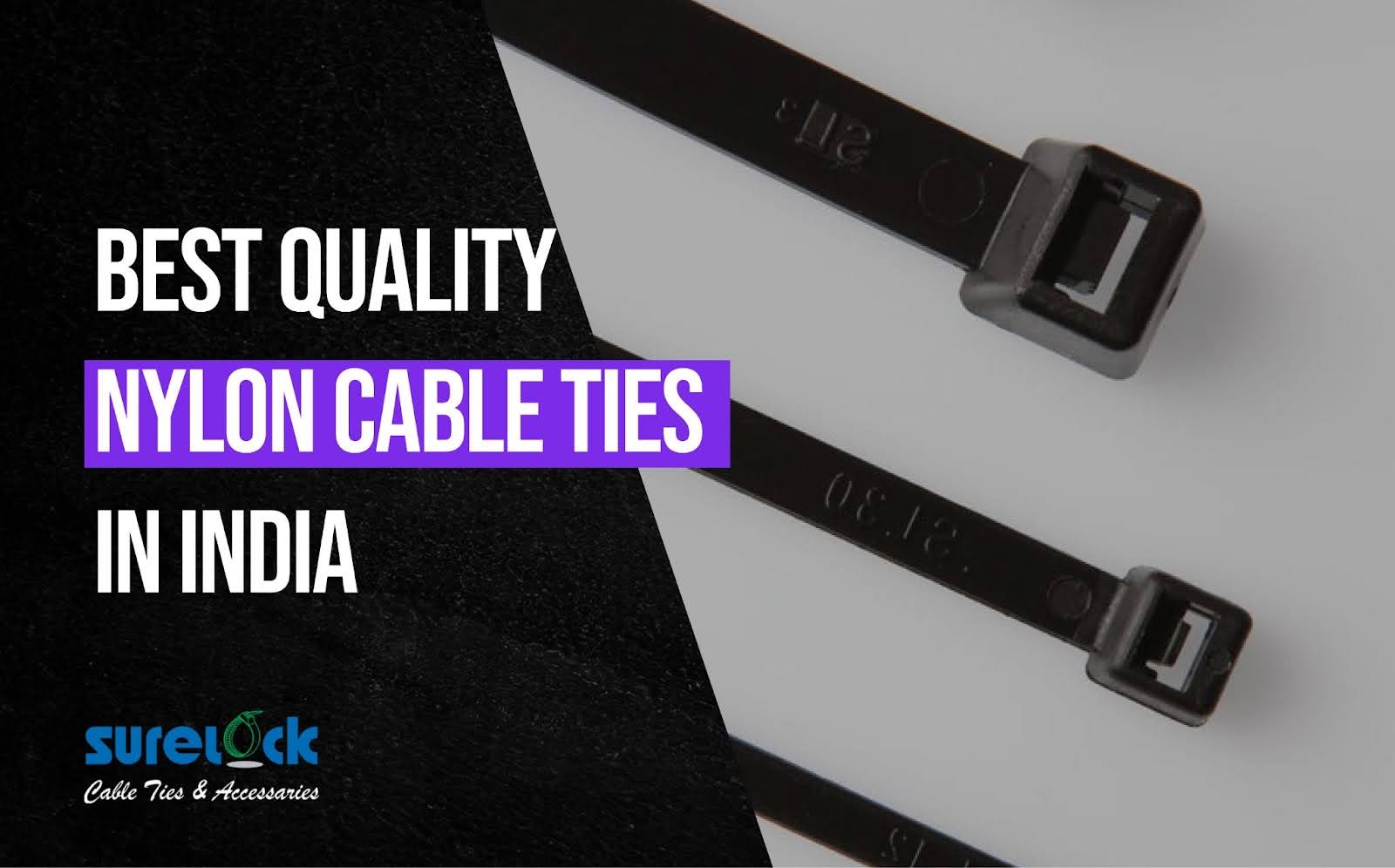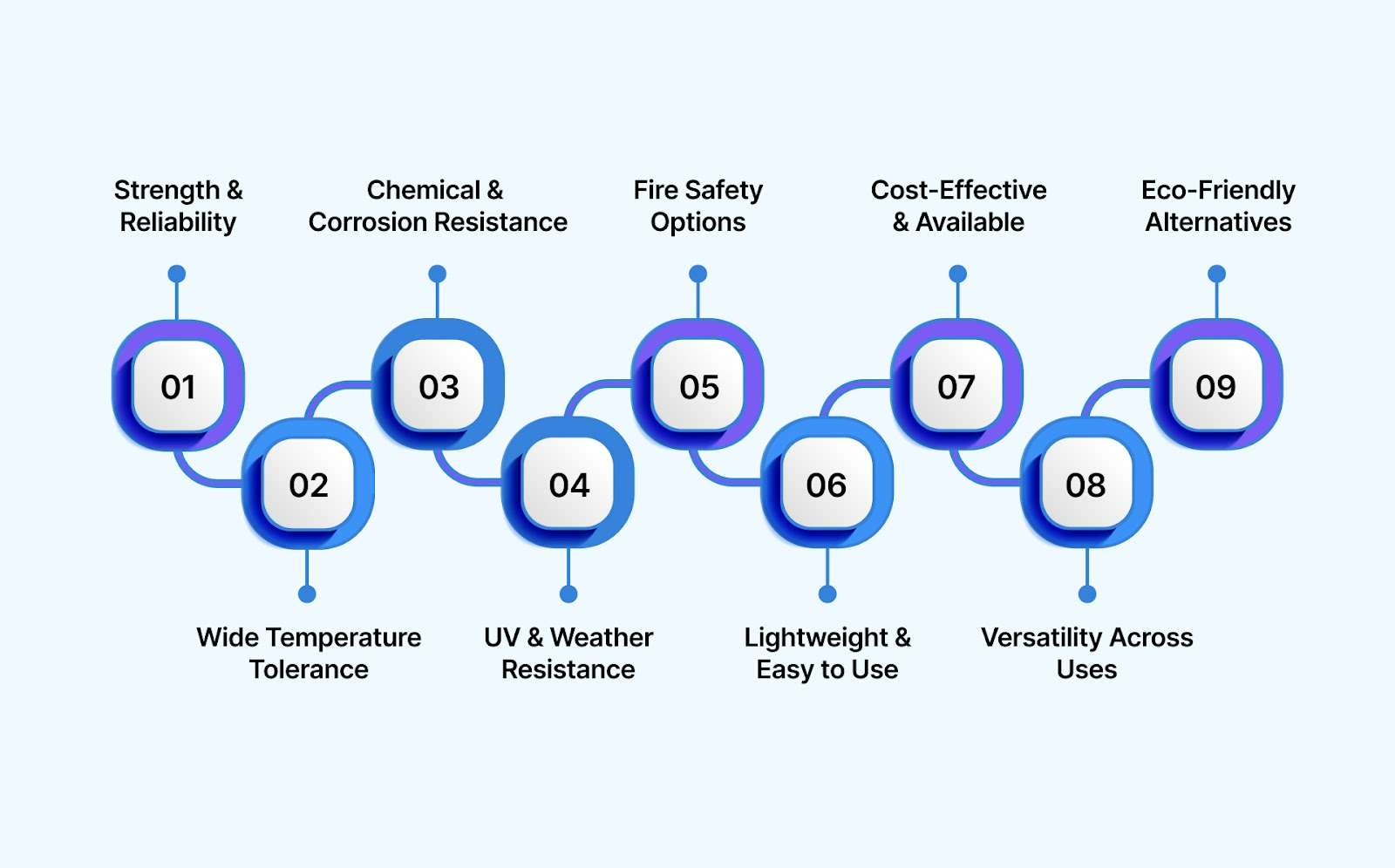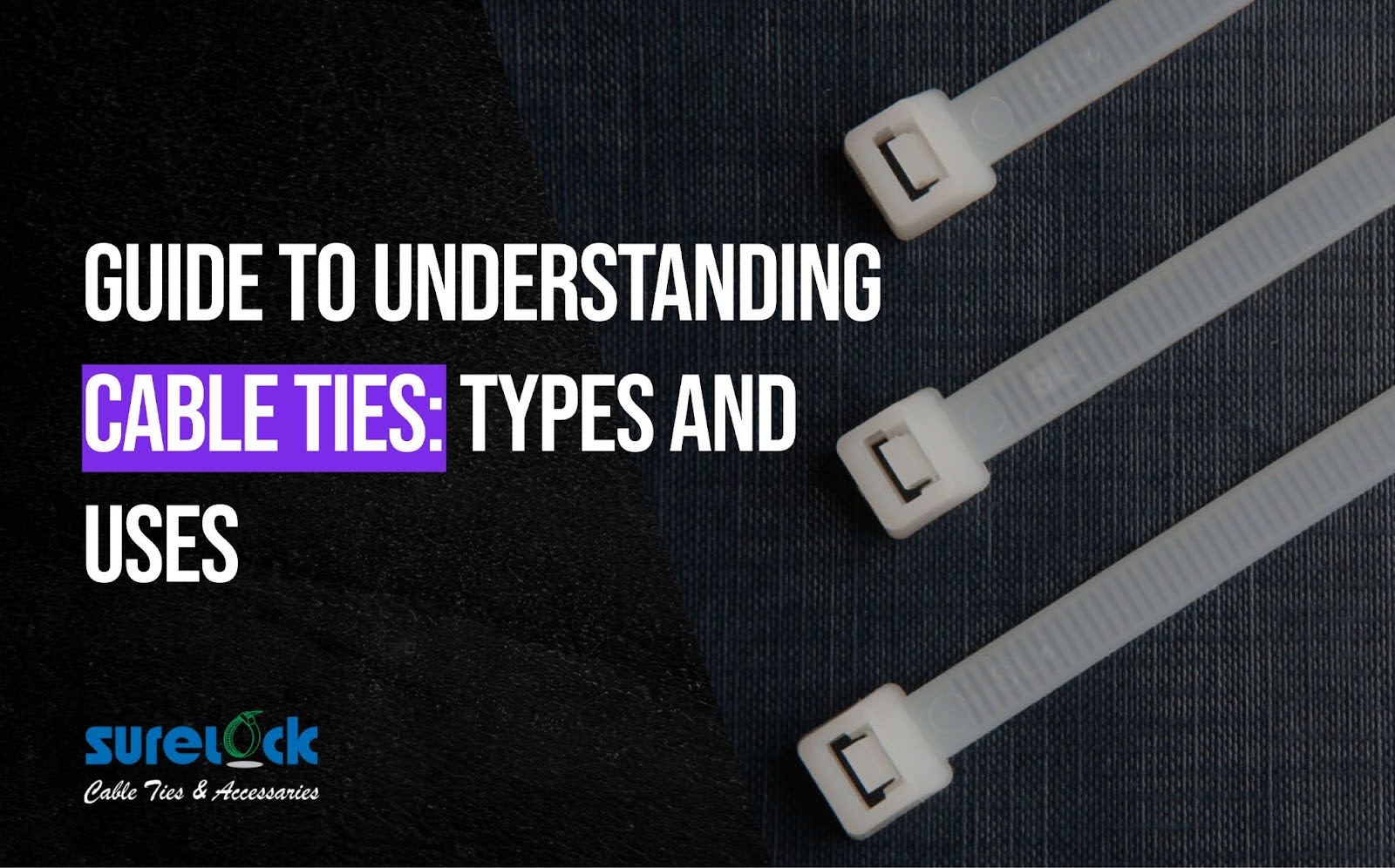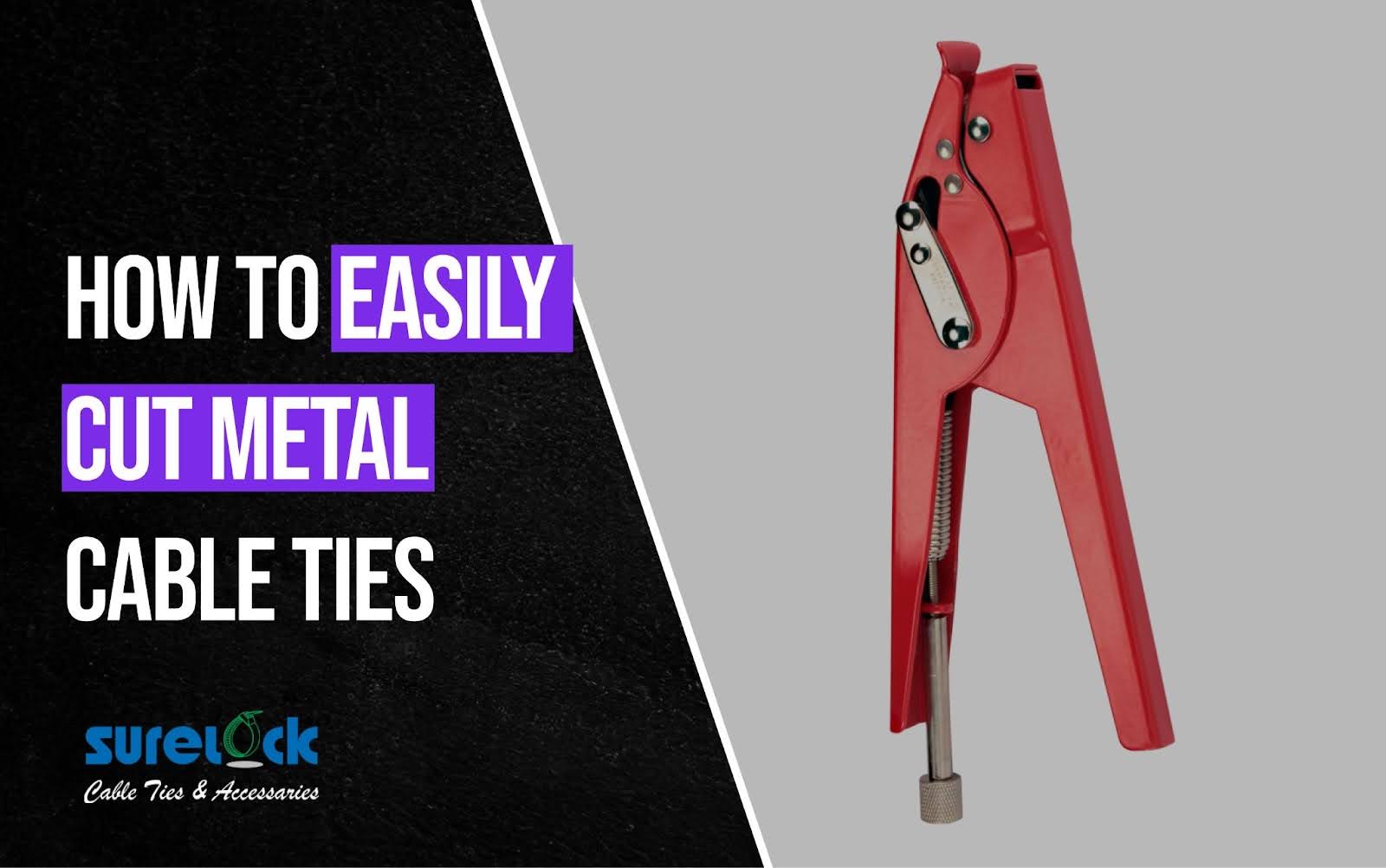Best Quality Nylon Cable Ties in India
October 10, 2025

Quick Summary
- Nylon cable ties are the most reliable and versatile solution for securing and managing cables.
- Best quality ties are durable, UV-resistant, flame-retardant, and tested for tensile strength.
- Surelock offers Non-Releasable, UV-resistant, Colored, and Special-Purpose Cable Ties to meet every application.
- Select the appropriate tie based on your indoor, outdoor, high-temperature, or identification requirements.
Introduction
When it comes to cable management, nylon cable ties are the most straightforward yet most powerful tool in your toolkit. They secure, organize, and protect wires across various industries, including electronics, telecom, construction, and automotive. But not all cable ties are equal. In this blog, we’ll explore what makes the best quality nylon cable ties in India, and spotlight Surelock’s trusted range.
Why Nylon Cable Ties Are the Preferred Choice?

Nylon cable ties have become the industry standard for cable management due to their combination of strength, versatility, and affordability. From home users to industrial electricians, they are trusted across multiple applications. Here’s why they stand out:
1. Superior Strength & Reliability
Nylon 6.6 (the most common material used) offers excellent tensile strength, ensuring that even large bundles of cables or heavy-duty applications remain secure. This makes nylon ties suitable for various industries, including construction, telecommunications, automotive wiring, and manufacturing.
2. Wide Temperature Tolerance
India’s climate can range from extreme heat to monsoon humidity. Standard nylon cable ties can typically withstand temperatures from -40°C to +85°C, while heat-stabilized versions can perform at even higher ranges. This ensures cables remain secure even in harsh industrial or outdoor environments.
3. Chemical and Corrosion Resistance
Nylon ties resist oil, grease, solvents, and mild chemicals, making them ideal for use in factories, automotive workshops, and chemical plants where exposure to these elements is common.
4. UV & Weather Resistance
Outdoor installations such as solar panel wiring, rooftop cabling, and telecom towers face constant exposure to sunlight. UV-resistant nylon cable ties are specially designed with additives to prevent brittleness and cracking, ensuring long service life outdoors.
5. Fire Safety Options
For high-safety environments such as server rooms, power plants, and industrial machinery, flame-retardant nylon cable ties are crucial. They slow down fire propagation, adding an extra layer of protection.
6. Lightweight & Easy to Use
Despite their strength, nylon ties are lightweight, compact, and easy to install with a simple hand tightening or cable tie gun. They provide fast and efficient bundling without the need for specialized tools.
7. Cost-Effective & Widely Available
Compared to metal or stainless steel cable ties, nylon options are far more affordable while still delivering strong performance. Their availability in bulk packs also makes them the economical choice for both household and industrial use.
8. Versatility Across Applications
Nylon cable ties are not just for cables; they’re also used for:
- Organizing home and office wires
- Bundling pipes and hoses in plumbing or HVAC
- Fixing signage and banners during events
- Securing agricultural nets or fencing
- DIY projects and crafts
9. Eco-Friendly Alternatives Emerging
Many manufacturers, including Surelock, are now exploring eco-conscious solutions, such as reusable or recyclable cable ties, which help reduce plastic waste without compromising on functionality.
What Defines “Best Quality” Nylon Cable Ties?
To identify the best quality nylon cable ties, it’s essential to consider factors beyond price and appearance, evaluating key performance indicators such as material grade, tensile strength, UV resistance, and fire safety ratings. By understanding these parameters, you can ensure you’re investing in cable ties that will deliver reliability, safety, and value across diverse applications.
Types of Nylon Cable Ties
Nylon cable ties come in many variants, each designed to serve a specific purpose. Choosing the right type depends on the application, environment, and level of durability required. Below are the most popular types:
1. Standard Non-Releasable Cable Ties
- Description: These are the most widely used ties, designed for permanent fastening. Once locked, they can’t be undone without cutting.
- Applications: Electrical wiring, home appliances, packaging, and industrial bundling.
- Advantages: Strong, economical, and available in a wide range of sizes.
2. Releasable Cable Ties (Light and Heavy duty)
- Description: These ties feature a built-in release mechanism that enables them to be easily undone and reused.
- Applications: Temporary bundling, trial setups, or projects that require frequent adjustments.
- Advantages: Cost-saving in the long run, eco-friendly, and versatile.
3. UV-Resistant Cable Ties
- Description: Manufactured with UV stabilizers to prevent cracking or degradation from sunlight exposure.
- Applications: Outdoor wiring, solar panel installations, rooftop cabling, and telecom towers.
- Advantages: Long-lasting, resistant to weather and harsh environments.
4. Heat-Stabilized / High-Temperature Cable Ties
- Description: Formulated to endure higher operating temperatures compared to standard ties.
- Applications: Automotive wiring near engines, industrial machines, and HVAC systems.
- Advantages: Prevents softening, melting, or premature failure under heat stress.
5. Fire-Retardant Cable Ties
- Description: Designed to resist fire and slow down flame spread.
- Applications: Server rooms, data centers, power plants, and safety-critical environments.
- Advantages: Provides an extra safety layer, often UL 94V-2 rated or higher.
6. Colored Cable Ties
- Description: Available in multiple colors for easy identification and bundling.
- Applications: Cable coding, telecom racks, labeling in industrial or home setups.
- Advantages: Simplifies organization, prevents confusion during troubleshooting.
Application-Based Selection Guide
Selecting the right nylon cable tie depends on where and how you plan to use it. Using the wrong type can lead to premature failure, safety issues, or frequent replacements. Here’s a deeper look into the most common applications in India and the recommended cable tie types:
Indoor Wiring & Control Panels
- Best Choice: Standard Non-Releasable Cable Ties
- Why: In control panels, household wiring, or office setups, cables are usually secured permanently. Standard nylon ties offer strength and neat organization.
- Pro Tip: For easy troubleshooting, combine with Colored Cable Ties to identify different circuits.
Outdoor / Rooftop Installations
- Best Choice: UV-Resistant Cable Ties
- Why: Direct sunlight and fluctuating weather conditions cause ordinary ties to become brittle. UV-resistant ties are specially designed with additives for outdoor durability.
- Common Uses: Solar panel wiring, rooftop internet cabling, CCTV installations, and telecom towers.
High-Temperature Environments
- Best Choice: Heat-Stabilized Cable Ties
- Why: Regular nylon may soften or degrade under constant exposure to high heat. Heat-stabilized versions retain their strength in industrial zones.
- Common Uses: Automotive wiring near engines, HVAC ducts, and manufacturing plants.
- Pro Tip: Always check the maximum operating temperature on the datasheet.
Fire-Prone / Safety-Sensitive Zones
- Best Choice: Fire-Retardant Cable Ties
- Why: Flame-retardant ties prevent rapid flame spread, protecting sensitive equipment and wiring.
- Common Uses: Server rooms, hospitals, chemical plants, metro/railway systems.
- Compliance: Look for UL 94V-2 or 94V-0 ratings.
Frequent Adjustments & Temporary Bundles
- Best Choice: Releasable or Hook-n-Loop Cable Ties
- Why: These ties can be reused multiple times, saving cost and reducing waste. Perfect for situations where cables need to be rearranged or replaced often.
- Common Uses: Stage lighting, event setups, temporary installations, and IT racks.
Cable Identification & Labeling
- Best Choice: Colored cable ties/Tag Cable Ties
- Why: In complex wiring systems, identifying bundles quickly saves time and reduces troubleshooting errors. Colored or tag ties simplify organization.
- Common Uses: Data centers, telecom racks, home theater setups, and industrial wiring.
Heavy-Duty Industrial Applications
- Best Choice: Wide & Heavy-Duty Nylon Cable Ties
- Why: These ties are designed for large-diameter bundles and high tensile loads.
- Common Uses: Securing pipes, ducts, cable trays, and heavy machinery wiring.
- Pro Tip: Always choose ties rated for the specific load requirement to prevent breakage.
Agricultural & Outdoor Utility
- Best Choice: UV-Resistant or Reusable Hook-n-Loop Ties
- Why: In farming, gardening, or outdoor construction, ties are exposed to sunlight and often need frequent adjustment.
- Common Uses: Netting, fencing, irrigation systems, greenhouse wiring.
Key Takeaway: Always match the cable tie to the environment (indoor vs outdoor), safety needs (fire-retardant), and reusability requirements. Surelock’s diverse product range ensures you’ll find the right solution for every scenario.
Best Practices for Cable Tie Longevity

Even the best quality nylon cable ties can underperform if they aren’t installed, maintained, or stored correctly. By following a few simple practices, you can significantly extend their lifespan and ensure safe, reliable installations.
1. Avoid Over-Tightening
- Why it matters: Excessive force can damage cable insulation, distort wire bundles, or even cause the tie to snap prematurely.
- Best practice: Use just enough tension to secure the bundle without crushing it. For precision, consider a cable tie tensioning tool, which ensures consistent application.
2. Trim Tails Cleanly & Flush
- Why it matters: Leaving sharp, jagged ends after cutting can cause injuries during maintenance and snag other wires.
- Best practice: Use a flush cutter rather than scissors or side cutters to create smooth edges.
3. Choose the Right Size & Width
- Why it matters: A tie that’s too small may break under load, while an oversized tie may not grip securely.
- Best practice: Select a tie length that is at least 25–30% longer than the bundle diameter and match the width to the load requirements.
4. Consider the Installation Environment
- Indoor vs. Outdoor: Use UV-resistant ties for outdoor projects to prevent brittleness caused by sunlight.
- Hot Zones: Use heat-stabilized ties near engines or machinery.
- Fire-Sensitive Areas: Use fire-retardant ties to meet safety regulations.
5. Regular Inspection & Replacement
- Why it matters: Nylon can degrade over time due to exposure to heat, UV rays, or chemicals.
- Best practice: In critical installations (e.g., telecom, solar, power plants), perform scheduled inspections and replace ties showing cracks, discoloration, or brittleness.
6. Proper Storage of Spare Ties
- Why it matters: Nylon absorbs moisture and can weaken if stored poorly.
- Best practice: Store ties in cool, dry, UV-protected containers away from direct sunlight. Avoid damp or excessively hot environments, as they can accelerate aging.
7. Use Specialized Ties for Special Applications
- Why it matters: Using standard ties in demanding environments may lead to premature failure.
- Best practice: For heavy-duty loads, use wide/industrial ties. For frequent adjustments, use releasable or hook-n-loop ties.
8. Bundle Smartly
- Why it matters: Random or uneven bundling stresses cables and ties.
- Best practice: Group cables logically (by function, color, or circuit) and distribute ties evenly along the length of the bundle.
9. Safety First in Cutting & Handling
- Why it matters: Careless removal of cable ties with knives can damage cables or cause injury.
- Best practice: Always use a dedicated cable tie cutter for safe and clean removal.
Conclusion
When it comes to choosing the best nylon cable ties in India, durability, material quality, UV and flame resistance, and certifications make all the difference. Surelock provides a comprehensive range that meets these standards, ensuring your installations are safe, reliable, and long-lasting.
Explore the full Surelock range here: Surelock Cable Ties.
Contact us for more details and information about our products and services.
FAQs
1. Which cable ties are best for outdoor use in India?
UV-resistant black nylon cable ties with stabilizers, like Surelock UV Resistant Cable Ties.
2. Can nylon cable ties withstand heat?
Yes, heat-stabilized variants can endure high-temperature environments without losing strength.
3. Are nylon cable ties reusable?
Standard ties are one-time use, but releasable and hook-n-loop ties are reusable.
4. Are flame-retardant cable ties necessary?
In fire-prone areas or critical installations, flame-retardant ties are essential for safety compliance.
5. Where can I buy the best quality nylon cable ties in India?
From trusted manufacturers like Surelock, which offers UL-approved, durable, and application-specific ties.



